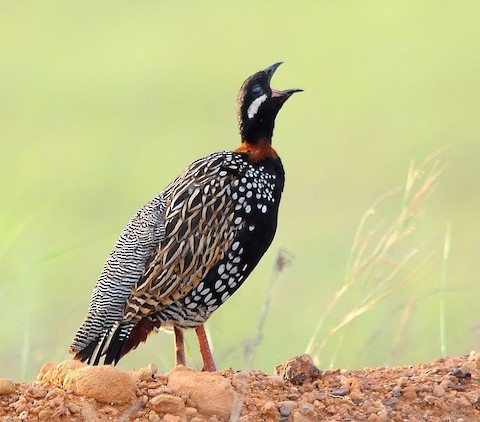Birdfinding.info ⇒ Typically shy and difficult to observe except when males call from prominent perches. Locally common in a few pockets of its large range. Consistent sites include: Agia Varvara and Akrotiri in southern Cyprus; the Hazore’a fish ponds, Kfar Yehoshu, and Kfar Baruch in northern Israel; and several areas in India, including the grasslands of western Gujarat, Saltanpur National Park, and feeding stations in the Nainital area of Uttarakhand. In Hawaii, it is most readily found in the northwestern quadrant of the Big Island (especially around Pu’u Anahulu, Pu’u Wa’awa’a Cinder Cone State Park, and the northern end of Saddle Road), central Maui (e.g., Kealia Pond National Wildlife Refuge and Hansen Road in Kaluhui), western Kauai (e.g., Polihale State Park, Kawaiele State Waterbird Sanctuary, Salt Pond Beach Park, and Waimea Canyon), throughout Molokai, and at Ka’ena Point on Oahu.
Black Francolin
Francolinus francolinus
Southern Asia, where it occurs in grassy scrub, savannas, light woodlands, and mixed agricultural land.
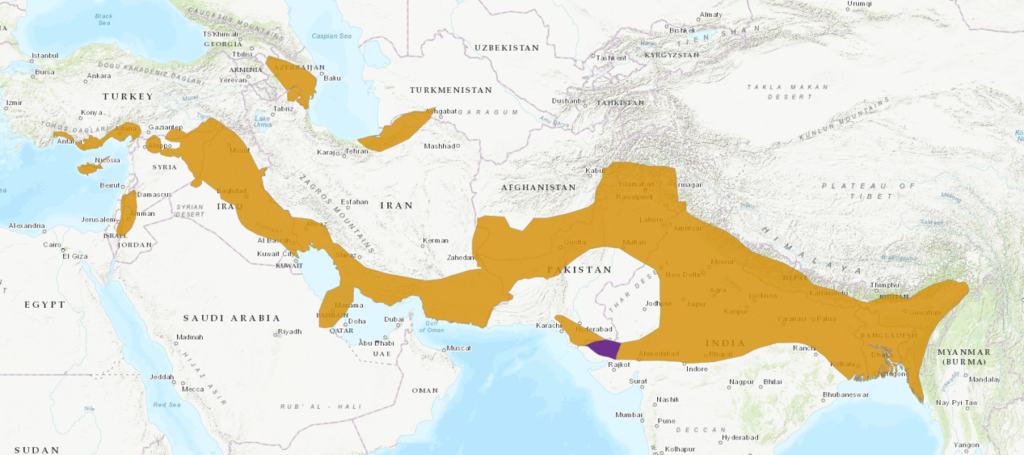
Approximate distribution of Black Francolin (but the portion crossing the Persian Gulf is clearly incorrect). © BirdLife International 2018
The bulk of its range is a nearly contiguous band of southern Asia that stretches from southern Turkey, Cyprus, and Israel east through Mesopotamia, southern Iran, southern Afghanistan, Pakistan, and northern India to western Myanmar.
Separately also in the Transcaucasian lowlands of eastern Georgia, Armenia, Azerbaijan, and northwestern Iran, and very locally around the southeastern corner of the Caspian Sea in northern Iran and southwestern Turkmenistan.
Formerly occurred farther west in Mediterranean Europe—reportedly west to Portugal. However, modern attempts to reintroduce it to Portugal, Spain, and Italy have failed.
Introduced populations are well-established on all of the main Hawaiian Islands, Guam, and Sir Bani Yas Island (Abu Dhabi).
From the 1960s through the ‘80s a small introduced population appeared to be established in southwestern Louisiana, but it vanished in the early 1990s.
Identification
Male is unique and unmistakable: mostly jet-black head and breast with a white cheek-patch and rufous-chestnut collar.
The crown and nape are finely streaked with pale-brown, white, and black—appearing “blond” at a distance.
The sides and belly are extensively spotted with white, and the vent is rufous-chestnut. The back and tail are finely barred black-and-white.
The wings and mantle are boldly striped with black, buffy, and brown.
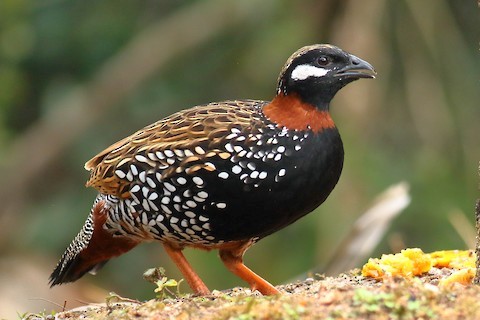
Black Francolin, male. (Bhimtal, Nainital, Uttarakhand, India; January 14, 2020.) © Amarendra Konda

Black Francolin, male. (Kepuhi Beach, Maui, Hawaii; February 25, 2014.) © Don Coons
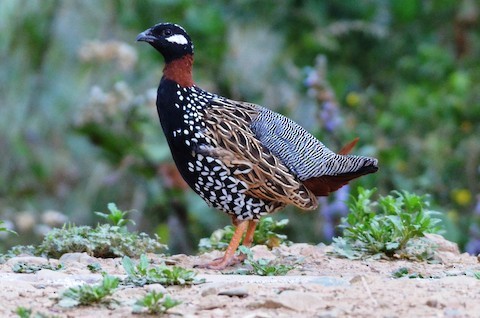
Black Francolin, male. (Sattal, Nainital, Uttarakhand, India; April 14, 2019.) © Ramesh Narula
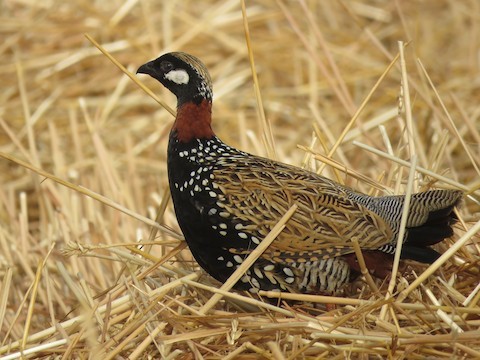
Black Francolin, male showing intricately patterned, multicolored upperparts. (Najafgarh Jheel, South West Delhi, India; April 12, 2018.) © Ritvik Singh

Black Francolin, male. (Sattal, Nainital, Uttarakhand, India; June 28, 2019.) © Sudhir Herle
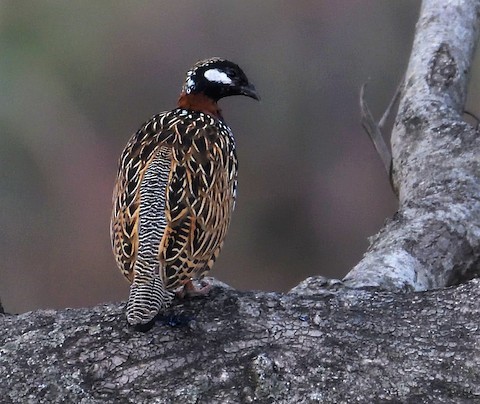
Black Francolin, male showing finely barred back and tail. (Vinayak, Nainital, Uttarakhand, India; May 9, 2019.) © Vijay S.
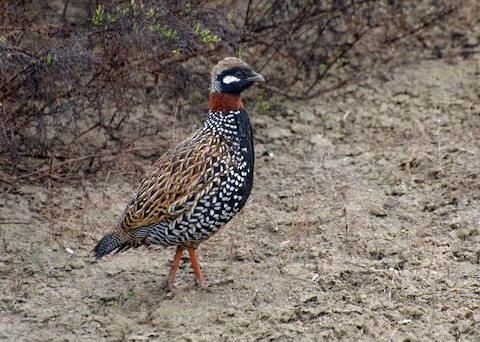
Black Francolin, male giving blond-headed impression. (Shirvan National Park, Salyan, Azerbaijan; February 2, 2020.) © Grigory Evtukh
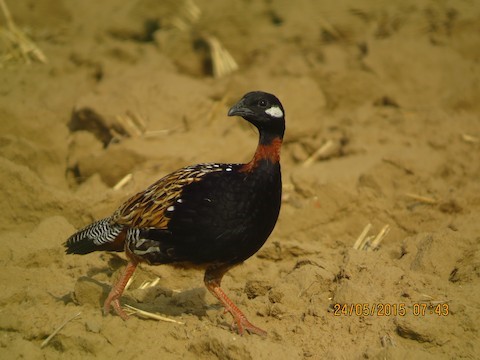
Black Francolin, male showing mostly black breast. (Sultanpur Flats, Gurgaon, Haryana, India; May 24, 2015.) © Ritvik Singh
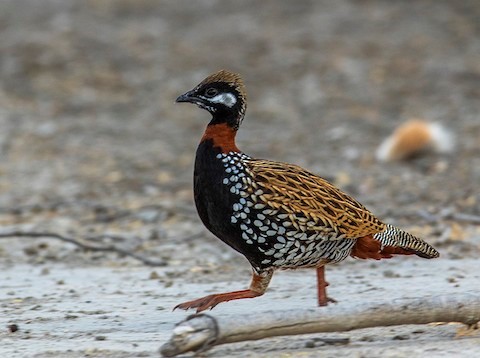
Black Francolin, male showing strong contrast in plumage. (Tal Chhapar Sanctuary, Churu, Rajasthan, India; January 22, 2019.) © Solomon Sampath Kumar

Black Francolin, male with mostly black-and-white upperparts. (Kutch District, Gujarat, India; August 5, 2008.) © Jugal Tiwari
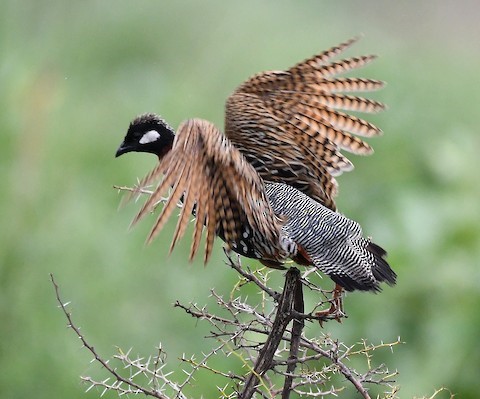
Black Francolin, male taking flight and showing extensive fine black-and-white barring on back and tail. (Kheda Jhanjhrola, Gurgaon, Haryana, India; July 25, 2019.) © Savithri Singh
Female is densely barred and streaked with white, gray, and pale brown. The overall coloration and density of markings vary geographically—the palest females are in southern Iran. The female’s face is mostly buffy with a dark gray ear-stripe.

Black Francolin, female. (Sattal, Nainital, Uttarakhand, India; June 28, 2019.) © Sudhir Herle

Black Francolin, female showing contrasty pattern. (Sattal, Nainital, Uttarakhand, India; May 9, 2015.) © Kalyan Singh Sajwan

Black Francolin, female. (Sattal, Nainital, Uttarakhand, India; April 11, 2018.) © Ramesh Shenai
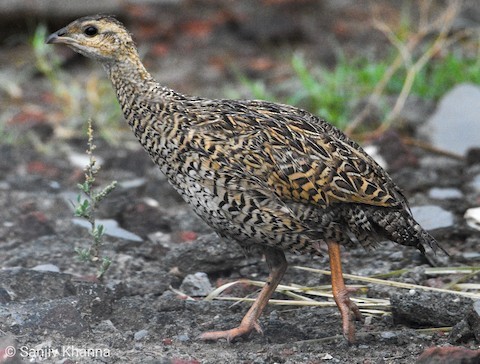
Black Francolin, female. (Jhal Thikriwala, Kapurthala, Punjab, India; July 25, 2019.) © Sanjiv Khanna
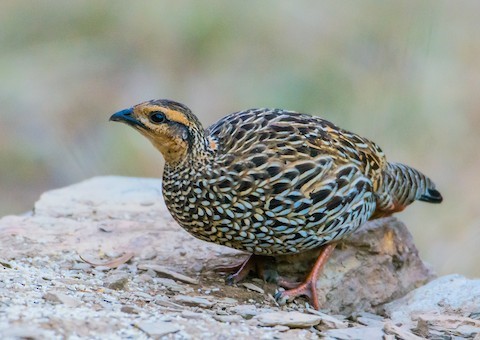
Black Francolin, female with rich-buffy face and generally contrasty plumage. (Pangoot, Nainital, Uttarakhand, India; March 24, 2019.) © Arunava Bhattacharjee
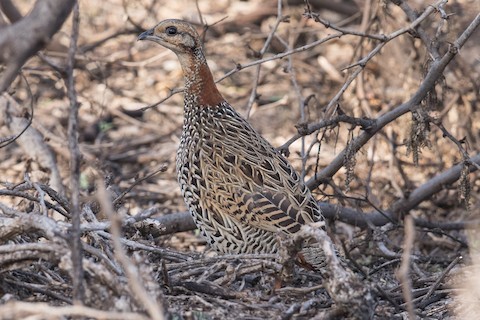
Black Francolin, female showing cryptic upperparts with rufous-chestnut nape patch. (Kahanui Pond, Maui, Hawaii; December 21, 2016.) © Eric VanderWerf
Voice. Male’s call is a distinctive, seven-syllable exclamation: a pair of notes, then three, then another pair. The cadence is consistent throughout its range but the calls vary in tone. Calls of the western subspecies tend to have a lower-pitched, richer quality: Calls of the eastern subspecies sound comparatively high-pitched, hoarse and scratchy, almost insectlike:
Notes
Polytypic species consisting of six recognized subspecies.
The western subspecies, francolinus and arabistanicus, (Turkey and Cyprus to Turkmenistan and western Iran), average 10-15% larger than the eastern subspecies (southern Iran to Myanmar), and the voices of western birds are lower-pitched and smoother than those of eastern birds. These differences have led some authorities to recognized eastern and western forms as distinct. However, the differences appear to be clinal and lack clearly corresponding differences in plumage or other traits.
References
BirdLife International 2018. Francolinus francolinus. The IUCN Red List of Threatened Species 2018: e.T22678719A131903818. https://dx.doi.org/10.2305/IUCN.UK.2018-2.RLTS.T22678719A131903818.en. (Accessed March 11, 2020.)
eBird. 2020. eBird: An online database of bird distribution and abundance. Cornell Lab of Ornithology, Ithaca, N.Y. http://www.ebird.org. (Accessed March 11, 2020.)
Madge, S., and P.J.K. McGowan. 2002. Pheasants, Partridges, and Grouse: A Guide to the Pheasants, Partridges, Quails, Grouse, Guineafowl, Buttonquails, and Sandgrouse of the World. Princeton University Press, Princeton, N.J.
McGowan, P.J.K., and G.M. Kirwan. 2020. Black Francolin (Francolinus francolinus). In: del Hoyo, J., Elliott, A., Sargatal, J., Christie, D.A. & de Juana, E. (eds.). Handbook of the Birds of the World Alive. Lynx Edicions, Barcelona. https://www.hbw.com/node/53386. (Accessed March 11, 2020.)
Mullarney, K., L. Svensson, D. Zetterström, and P.J. Grant. 1999. Birds of Europe. Princeton University Press, Princeton, N.J.
Pyle, R.L., and P. Pyle. 2017. The Birds of the Hawaiian Islands: Occurrence, History, Distribution, and Status. Version 2 (January 1, 2017). http://hbs.bishopmuseum.org/birds/rlp-monograph/. B.P. Bishop Museum, Honolulu, Hawaii.
